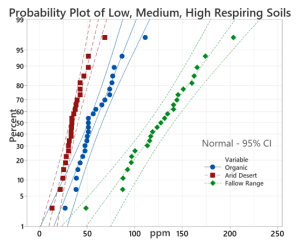
Statistical distribution plots show that Solvita labs clearly and normally distinguished different soils
WOODS END LAB released findings of the 2021 Solvita Proficiency test examining performance of thirty soil labs worldwide which use Solvita for soil quality tests. Four soil types were selected including fallow and arid rangeland, and intense tilled organic and conventional. The statistical findings revealed “normal distribution” (expected variation around the median) with most but not all labs able to reliably determine differences between the soil samples. For “CO2-Burst”, all labs successfully scored the fallow rangeland (NM soil) as highest respiring and the arid desert soil as the lowest. Both intensive farms (conventional and organic) scored closely in the mid-range with organic slightly higher. A core group of labs distinguished 3 significant levels of respiration (low, med, high) while most labs distinguished at least two groups (high vs medium-low) using a statistical process called “Tukey mean separation”. Analysis of interaction effects was applied for robustness quantification. Outliers (which may also be “bad values” or “gross errors”) relate to how well labs perform the method. The Q&A process identified incorrect protocol (failure to use current SOP) and use of outdated equipment (not maintaining current rev level) as chief cause of aberrant values. Certain labs performed the “Haney” test using an IR (infrared) device as an alternative to Solvita. For this comparison, a subset of 12 different soils were furnished single-blind to compare alternate-IR to Solvita and to an independent infrared check standard. The findings showed that none of the Haney lab IR-respiration results correlated to the IR check standard and no correlation was found between the Haney labs. The project used OM-LOI as a surrogate test for soil quality. LOI is a decades-old procedure, but results showed a fairly broad range of results (Fig 2). The Q&A indicated labs employ different SOPs for the combustion procedure. Overall, the findings with outlier analysis (Fig 3) suggest that Solvita can produce fully accurate and repeatable results, but some labs need to improve practices and maintain scheduled Solvita updates for highest quality results. A copy of the full report may be requested from lab@woodsend.com, a summary can be downloaded here.

